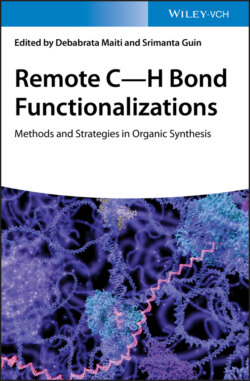Читать книгу Remote C-H Bond Functionalizations - Группа авторов - Страница 14
2.2.2.2 Phenylacetic Acid Derivatives
ОглавлениеThe generality of the template strategy in accommodating potential macrocyclopalladation processes with smaller ring sizes was also investigated with phenylacetic acid derivatives. Notably, the Fujiwara–Moritani‐type olefination is often used as the effective model reaction to test feasibility of a new substrate design of meta‐C–H activation relation. In 2014, the Maiti group introduced a new category of nitrile‐based phenolic directing template, which is now available from Sigma Aldrich as the Maiti–Bera–Modak (MBM) auxiliary, for meta‐C–H olefination of phenylacetic acid derivatives via an ester linkage (Scheme 2.10) [20]. In this new class of substrates, a smaller 12‐membered cyclic transition state was proposed for the palladation step than hydrocinnamic acid derivatives. With this easily synthesized and removable 2‐hydroxybenzonitrile template, a broad range of phenylacetates were olefinated in a highly mono‐selective as well as meta‐selective fashion. Moreover, this protocol was also applied to drug molecules such as ibuprofen in a moderate yield and selectivity, products of which are difficult to access using conventional methods of diversification.
Scheme 2.10 meta‐C–H olefination of phenylacetate.
Source: Modified from Bera et al. [20].
Simultaneously, Yu and coworker disclosed a protocol of the commercially available dibenzonitrile directing template assisted meta‐C–H olefination of phenylacetic acid derivatives via an amide linkage [21]. Notably, N‐formyl‐protected glycine (Formyl‐Gly‐OH) was identified as the new ligand for this new class of substrate. Unlike previous protocols, weak base KH2PO4 was required to use as the crucial additive. This reaction further demonstrates the good versatility of the template approach in accommodating potentially necessary macrocyclopalladation processes with different ring size for different classes of substrates (Scheme 2.11) [21].
Scheme 2.11 meta‐C–H olefination of phenylacetic acid derivatives. Source: Modified from Deng et al. [21].
In 2017, the Maiti group developed the first rhodium‐catalyzed meta‐C–H olefination of phenylacetic acid frameworks with the assistance of 2‐hydroxy‐4‐methoxy benzonitrile template (Scheme 2.12) [22]. The XPhos (2,4′,6′‐diisopropyl‐1,1′‐biphenyl‐2‐yldicyclohexylphosphine) was identified as the crucial ligand for this reaction. Substituents of phenylacetic acid esters at all positions of the arene ring were found to be tolerated. Synthetic application of this protocol was also expanded to the diversification of ketoprofen, a drug molecule containing a secondary α‐methyl substituent.
Scheme 2.12 Rh‐catalyzed meta‐C–H olefination of phenylacetic acid derivatives.
Source: Modified from Bera et al. [22].
Besides nitrile‐based templates, N‐containing heteroarene‐based templates also proved to be applicable for the phenylacetic acid frameworks (Scheme 2.13) [23]. In 2017, Yu and coworkers reported the a Pd‐catalyzed meta‐C–H olefination of phenylacetic acid scaffolds using a pyridine‐based template via an amide linkage. A variety of phenylacetic acids, including cyclic and heterocyclic substrates, were efficiently meta‐C–H olefinated in HFIP solvent without using additional ligand, opening new avenues for potential utility in C–H functionalization of advanced intermediates and late‐stage modifications. Notably, the template could be used to extend the reaction scope to cross‐coupling and iodination reactions (vide infra).
Scheme 2.13 Pyridine‐based template assisted meta‐C–H olefination of phenylacetic acid derivatives.
Source: Modified from Jin et al. [23].
A novel N‐containing pyrimidine‐based template was also utilized to enable meta‐C–H perfluoroalkenylation of phenylacetic acid derivatives by Werz, Zanoni, Maiti, and coworkers for the synthesis of organofluorine compounds (Scheme 2.14a) [24]. Notably, perfluoroalkenylation of drug molecule Ibuprofen was also possible with this protocol and the cleavage of the template is facile.
Scheme 2.14 (a) meta‐C‐H perfluoroalkenylation of phenylacetic acid derivatives. (b) meta‐C‐H alkenylation of phenylacetic acid derivatives with electron‐deficient coupling partners.
Source: (a) Modified from Brochetta et al. [24]; (b) Modified from Jiao et al. [25].
Meanwhile, Wang, Zhou, and coworkers also reported a close protocol using olefin coupling partners other than perfluoroolefins such as acrylates (Scheme 2.14b) [25].
As mentioned earlier, pyridine‐based template has been devised for meta‐C–H olefination of phenylacetic acid scaffolds by the Yu group [23]. In the same report, it was also demonstrated that the meta‐C–H activation with this template could be extended to meta‐C–H cross‐coupling with potassium trifluoroborate and meta‐C–H iodination with 1,3‐diiodo‐5,5‐dimethylhydantoin (DIH) (Scheme 2.15) [23]. These results indicated that by tuning the distance and geometry a commonly used ortho‐directing group (i.e. pyridyl) can be engineered to produce novel meta‐directing templates for activating remote meta‐CH bonds.
Scheme 2.15 Pyridine‐based template assisted meta‐C–H arylation and iodination of phenylacetic acid derivatives.
Source: Modified from Jin et al. [23].
Deuterium‐labeled compounds are widely used in pharmaceutical industry and kinetic studies of chemical reactions. However, deuterated compounds are often prepared with multistep synthetic routes. In 2019, by using the easily removable pyrimidine‐based templates, Werz, Maiti, and coworkers realized the Pd‐catalyzed meta‐C–H deuteration of phenylacetic acid derivatives with easily available deuterium source such as deuterated acetic acid [26]. Notably, the method could be successfully been applied to several drug molecules such as Flurbiprofen (Scheme 2.16a). Simultaneously, Yu, Dai, and coworkers also achieved similar meta‐C–H deuteration with a pyridine‐based template (Scheme 2.16b) [19].
Scheme 2.16 (a) meta‐C–H deuteration of phenylacetic acid derivatives pyrimidine‐based templates. (b) meta‐C–H deuteration of phenylacetic acid derivatives pyridine‐based templates.
Finally, Pd‐catalyzed meta‐C–H allylation of phenylacetic acid derivatives has also been achieved with pyrimidine‐based template utilizing synthetically inert unactivated acyclic internal olefins as allylic surrogates, but only limited examples were disclosed [27]. In short, meta‐C–H transformation of phenylacetic acid derivatives includes olefination, arylation, iodination, and deuteration with Pd(II) or Rh(III) catalysts, using nitrile‐based or N‐heterocycle‐based templates.
